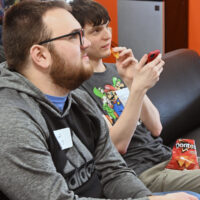Celebrating Disability Pride Month: Embracing My Journey
By Brandon Scott, Content Creation Manager, Easterseals Crossroads
Every July, I celebrate Disability Pride Month with a deep sense of joy and empowerment. As a person with a physical disability who uses a power wheelchair and has no arms or legs, this month holds a special significance for me. It is a time to reflect on my journey, embrace my identity and advocate for the rights and recognition of people with disabilities. This celebration is deeply intertwined with the mission of Easterseals Crossroads, an organization dedicated to enhancing the quality of life for individuals with disabilities (like me) and their families.
Celebrating Identity
Disability Pride Month is a celebration of our identities as individuals with disabilities. For me, it’s a reminder that my disability is not something to be hidden or ashamed of, but rather a vital part of who I am. My power wheelchair is not just a piece of equipment; it’s an extension of myself, giving me the freedom to navigate the world.
Living without arms and legs presents unique challenges, but it also offers a perspective that enriches my life in unexpected ways. Throughout my life, Easterseals Crossroads has played a crucial role in this journey. From attending summer camps as a kid to home modification assistance as an adult, these supports and resources have helped empower me to live my life to the fullest.
From an early age, my parents wanted to find a place that would help me learn and grow with my disability and that is exactly what they found in Easterseals Crossroads. This organization helped me embrace my disability and helped me with the journey of self-discovery and self-acceptance. Disability Pride Month is a time to honor that journey.


Raising Awareness
One of the most significant aspects of Disability Pride Month is raising awareness about the experiences and challenges faced by people with disabilities. It’s an opportunity to educate others about the barriers we encounter and the need for greater accessibility and inclusivity.
By sharing my story, I hope to shed light on the realities of living with a physical disability and inspire others to advocate for positive change. My power wheelchair, for example, is essential for my mobility, but public spaces often lack the accessibility features I need to navigate comfortably, whether it be parking that is not big enough to accommodate the ramp on my van (or someone parking in the blue striped loading zone), automatic door buttons that do not work or aisles that are too small to maneuver a wheelchair.

Universal design for all public places is a huge component of accessibility. When this concept is fully embraced in all of our community spaces and buildings, it will be a great source of pride for everyone regardless of ability or disability. Easterseals Crossroads is committed to raising awareness and promoting an understanding of universal design as the standard for which to adhere.
My time at Easterseals Crossroads, as both an individual receiving services and now as a current employee, has given me the necessary tools and platform to be a voice of awareness.
Advocating for Rights
Disability Pride Month is also about advocacy. It’s a time to highlight the importance of disability rights and push for policies that promote equality and inclusion. As someone who relies on a power wheelchair, I understand firsthand the critical need for accessible public spaces, transportation and technology. Living without arms and legs means that I depend on accessible technology and environments to communicate, work and engage with my community.
By celebrating this month, we increase our voices and work towards a society where people with disabilities have equal opportunities to thrive.
I also recognize that we have come a long way as a society thanks to the passing of the Americans with Disabilities Act (ADA) 34 years ago. The groundwork this act laid gives us a great guide to understanding where we were and where we still need to go. Without the passing of the ADA, things like going to the grocery store independently would not be possible. I love grilling out; not being able to go grocery shopping would affect my ability to get the most out of a passion.
As a leader here in Central Indiana, Easterseals Crossroads advocates for the rights of individuals with disabilities, striving to ensure that everyone has access to the resources and opportunities they need to succeed.
Building Community
The sense of community that comes with Disability Pride Month is incredibly empowering. Connecting with others who share similar experiences fosters a sense of belonging and mutual support. It’s a chance to celebrate our achievements, share our struggles and learn from one another. Being part of a resilient community reminds me that I am not alone in my journey. Through my involvement with Easterseals Crossroads, I have met many inspiring individuals who, like me, face daily challenges with courage and determination. Easterseals Crossroads fosters this sense of community, offering programs and services that bring people together and create lasting connections.
Challenging Stereotypes
Disability Pride Month challenges the stereotypes and misconceptions that often surround people with disabilities. It’s a time to showcase our strengths, talents and contributions to society. By celebrating our diverse abilities, we break down the barriers of ignorance and prejudice.
My disability does not define my capabilities or limit my potential; instead, it has shaped my resilience and determination. It has taught me that I can truly accomplish anything I put my mind to – it doesn’t matter if it is as small as learning how to brush my own teeth or as big as learning how to drive a car. My journey of living without arms and legs has taught me to adapt, innovate and thrive in ways that defy conventional expectations.


Here at Easterseals Crossroads, we work tirelessly to challenge these stereotypes, promoting a positive and accurate portrayal of individuals with disabilities.
Honoring the Past, Inspiring the Future
Finally, Disability Pride Month is a time to honor the pioneers who fought for disability rights and created a path for future generations. Their courage and perseverance inspire me to continue advocating for a more inclusive world. By celebrating this month, we acknowledge their legacy and commit to carrying forward their vision of equality and justice. Easterseals Crossroads honors this legacy by continuing to advocate for systemic change and supporting individuals with disabilities in achieving their goals.
Disability Pride Month is a powerful reminder of the strength, resilience and beauty of the disability community. For me, it’s a time to celebrate my identity, raise awareness, advocate for rights, build community, challenge stereotypes and honor the past. It’s a month of empowerment and pride, and I am grateful for the opportunity to celebrate it each year.
Through this celebration, we continue to push for a world where everyone, regardless of their abilities, can live with dignity, pride and equality. With the support of organizations like Easterseals Crossroads, we can make this vision a reality, ensuring that everyone has the opportunity to lead a fulfilling and independent life.














